Seagate Enterprise NAS HDD 6 TB Review
by Ganesh T S on December 10, 2014 8:00 AM EST- Posted in
- NAS
- Storage
- Seagate
- HDDs
- Enterprise
RAID-5 Benchmarking - Miscellaneous Aspects
Consumers are rightly worried about RAID rebuilds and the scope for drive failures during that process. As one of our evaluation aspects, we randomly yanked out a disk during operation and cleaned it up for rebuild. We recorded the resync duration (time taken to rebuild a 3-disk RAID-5 volume when one of the disks needs to be replaced) as well as the average power consumption during that process. The two aspects, considered together, give an idea of the efficiency of the hard drive. The graph below presents the total energy consumption (Resync Power Consumption (W) X Resync Duration (s)) for the resync.

While the energy consumption aspect provides a consolidated view of the various factors, it is still worthwhile to look at the power consumption and resync duration numbers separately. The table below provides the raw information behind the above graph. The numbers are very similar to the Enterprise Capacity v4, with a slight edge for the Enterprise NAS HDD.
| RAID-5 Resync Power Consumption & Duration | ||
| Drive | Power (W) | Duration (s) |
| Seagate Enterprise NAS HDD | 101.91 | 37284 |
| WD Red | 90.48 | 52072 |
| HGST Ultrastar He6 | 95.36 | 45260 |
| Seagate Enterprise Capacity v4 | 105.42 | 37462 |
We also measured power consumption during the last stage of our multi-client test. With 25 different clients simultaneously stressing the NAS with different types of workloads, we recorded the power consumption at the wall for the NAS as a whole. The various numbers are presented in the graphs below.
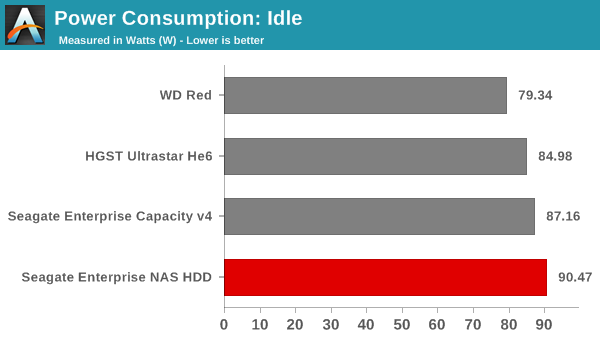
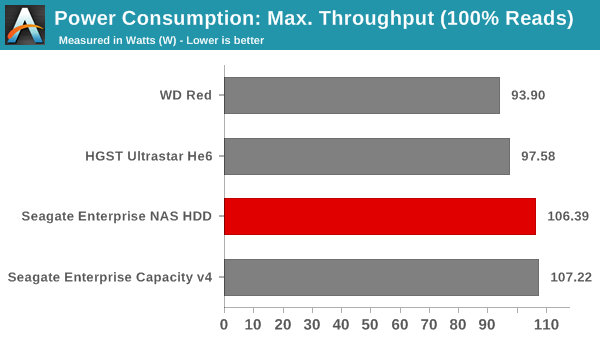
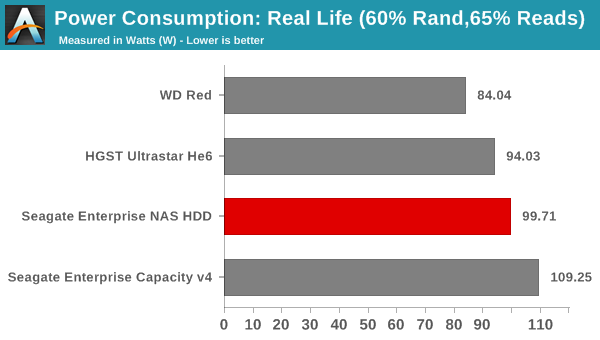
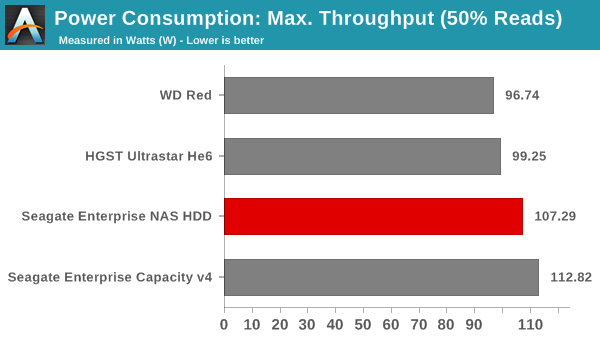
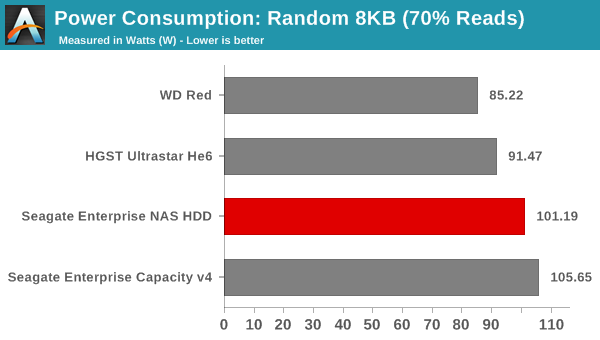
As expected, the units providing better performance have higher power consumption numbers. Workload numbers closely track the rebuild power consumption. The HGST Ultrastar He6, while providing equivalent performance, manages to keep the power consumption low because of the sealed Helium-filled environment for the platters. The Seagate Enterprise Capacity v4 and Enterprise NAS HDD are traditional hard drives that are able to achieve the capacity points using platters with higher storage density (six platters with 1TB/platter).










51 Comments
View All Comments
cm2187 - Wednesday, December 10, 2014 - link
+1MikeMurphy - Wednesday, December 10, 2014 - link
Exactly.tocker - Wednesday, December 10, 2014 - link
We could place bets. I'm going for a 40% failure rate inside of 3 years.Thats probably being generous.
Laststop311 - Thursday, December 11, 2014 - link
https://www.backblaze.com/blog/hard-drive-reliabil...Hitachi has the lowest failure rate in a massively huge deployment of HDD's in a cloud storage facility. Gives you a pretty good idea just how amazing they are.
ddriver - Sunday, December 14, 2014 - link
Yeah, but that's not a given, remember back in the days where those same deskstar disks were called deathstar cuz they were dropping down life flies?It would be nice of more cloud storage provides post their stats so that regular people know what to buy.
Zap - Wednesday, December 10, 2014 - link
What RPM are these drives? I know manufacturers like to obfuscate this information, but as a consumer I'd like to know.wavetrex - Wednesday, December 10, 2014 - link
That raw read/write speed is typical for 1TB platters on a 7200rpm drive.My guess is that speed is the comfort zone for these drives, and they probably spin down to 5400 when idling to reduce power consumption
MrSpadge - Wednesday, December 10, 2014 - link
No matter what WD likes to tell you with "IntelliPower" etc. drives do not normally run at different speeds. The mechanics, head aerodynamics / fly height and everything must be tailored to a specific spindle speed. Changing it on the fly has so far been unfeasible and wouldn't be much quicker than simply spinning down at idle, yet provide a only a small fraction of the power savings.hlmcompany - Wednesday, December 10, 2014 - link
IntelliPower and WD don't say that the drive changes speed during operation. An IntelliPower drive is a fixed speed, but set to meet certain power requirements. Because of this not all IntelliPower drives are at the same spindle speed.http://wdc.custhelp.com/app/answers/detail/a_id/36...
Navvie - Wednesday, December 10, 2014 - link
When 'IntelliPower' was first introduced WD were very secretive about exactly what it meant. Although there are now sources, their vague comments on exactly what IntelliPower is lead people to the conclusion that the drives were adjusting speed depending on demand.I believe the clever guys at SPCR were the first to determine the speed of IntelliPower drives by looking at the drives harmonics.